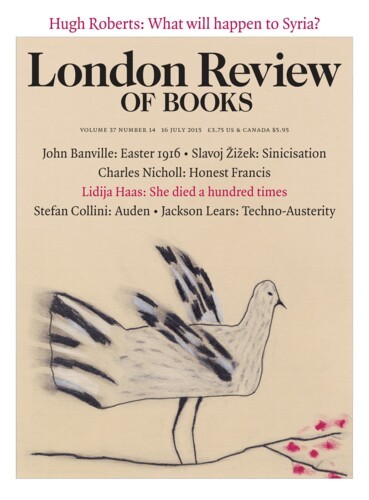Close-up of Amy Winehouse. Not the stylised mask of later years, with its extravagant licks of eyeliner. What you’re seeing is a quite different face, that of, as one record exec recalls her, ‘a classic North London Jewish girl’, large-eyed, fleshy, constantly in motion; it belongs to someone mouthy, beguiling and almost resplendently ordinary. Off-camera, a female interviewer appears to be trying to get Winehouse to join her in pontificating on women musicians who write about their personal lives: Dido, the interviewer insists, really ‘cleaned out her emotional closet’ on her last record. ‘Did she?’ Winehouse asks sarcastically, leaking contempt on Dido, her emotions, her insipid music, but most of all on the hapless journalist. As the woman talks on, Winehouse’s expression shifts. Mugging for the camera, mocking her interlocutor, she reminds you that long before the press made her into a punchline, she was a comedian.
This is a scene from Amy, a new documentary by Asif Kapadia, whose previous films include two – The Warrior and Far North – that pit an individual against a vast, inhospitable landscape; one aberrance in the form of a Hollywood thriller starring Sarah Michelle Gellar; and Senna (2010), a documentary about the Formula One driver pieced together from 15,000 hours of archival footage. As Kapadia told the New York Times, there are few people about whom you could make a film like Senna, because he was so famous that, anywhere in the world, ‘whenever he goes to work there is a camera there. So you have his work and his career and his death all on camera.’ Winehouse’s tabloid fame in the years preceding her death in 2011 at the age of 27 puts her in a similar category, although unlike Senna, who seems to have been more or less unaware of or unfazed by being filmed, she has a dynamic relationship with the camera, shifting from a playful, often flirtatious presence in early footage shot by friends, to an increasingly weary, lonely, spied-on expression as the paparazzi close in.
Each of these documentaries shapes a sympathetic portrait of a thoughtful, sensitive person, exceptionally gifted in their field, who we as viewers know is heading for a disaster (one quality of found footage is dramatic irony; no one on the tapes can know what the audience does). Stars of sport and pop music are similarly susceptible to being underestimated, seen as instinctive talents (which helps create a sense of fatedness around them), and Kapadia is determined not to portray his protagonists that way: in Senna, the manager of the McLaren team talks about watching him drive early on and being impressed by his pace and dedication, but most of all by his mind, because ‘in the end what you’re looking for is an intellect.’ It’s clear that with Amy, as with Senna, Kapadia doesn’t want to show only the crash: it is, after all, the part of her story we’ve already seen in excruciating detail. Kapadia knows how to let inner life emerge: Senna doesn’t tell us much about the driver’s private life, it isn’t a biography in a traditional sense, and yet, seeing what Senna sees through the windscreen during a race; seeing him small, from above, on the track; seeing emotion flicker across his face close up, from far away, from many angles; seeing his smile as he powers through waves on a beach, you begin to see a whole person.
Like Senna’s, Winehouse’s family co-operated with Kapadia, but unlike them, they are displeased with the film, and it’s not hard to see why. As well as a welcome portrait of the frequently caricatured Winehouse as an (exceptional) artist and as a person, Amy is an indictment of those around her, especially her ex-husband, Blake Fielder-Civil, with whom she developed a set of addictions that derailed her life, her manager, Raye Cosbert, and her father, Mitch, all of whom are portrayed as prioritising her career (and thus theirs) over her health. It is rare to see a non-fiction film in which the goodies seem so good and the baddies so bad, and the effect can be confusing, especially for those of us whose existing assumptions about what happened to Winehouse align with what is shown here. Are we being pandered to? Footage of Fielder-Civil, both from before and during his disastrous relationship with Winehouse, is difficult to watch, and I wondered several times whether the expression of smug, bratty cunning on his face was at least in part a projection of mine, or the director’s. (Having said that, if there’s a more appealing side to Fielder-Civil, it’s not obvious. ‘I can’t sing, so therefore Amy’s life is the only one that is ever valid,’ he recently complained to an interviewer. ‘I almost feel like I’m being punished.’)
The film would be less powerful without the co-operation of Winehouse’s childhood friends and especially her first manager, Nick Shymansky, whom she’d known since her teens and who provided a lot of good footage. These friends are shown as always thinking of Winehouse’s welfare; the section of the film that seems to have bothered Mitch most is the one in which his daughter’s friends discuss wanting her to get help for a problem with alcohol in 2005, before ‘Rehab’ made her an international star and everyone ‘wanted a piece of her’. Mitch objects to footage of himself saying she didn’t need to go, which he claims has been misleadingly edited, but it’s an odd claim given that this episode is immortalised in her best-known song (‘I ain’t got the time/And if my daddy thinks I’m fine’). Shymansky says they ‘lost a very key opportunity’ there. ‘We could have fucked Back to Black off,’ he says, ‘Back to Black might never have happened, but she’d have had a chance.’ There’s a very affecting voicemail message in which she announces herself as Nick’s ‘favourite Jewish girl. Apart from your mum’, and asks why he never returns her calls anymore (though you do wonder how and why he came to keep something like that). Cosbert describes her decision to work with him instead of Shymansky as the sort of thing people feel they need to do sometimes, ‘like switching bank accounts’, a regrettable image that Kapadia underlines with footage of Winehouse wandering serenely around with Nick and turning her face, eyes closed, up to the sun.
Winehouse drifted away from the old friends and colleagues who kept trying to help, and further into the orbit of Fielder-Civil, her father and Cosbert. Fielder-Civil says, in a low, somewhat chastened voiceover, that she first tried crack and heroin, which he’d already begun using, when they returned, married, from America. Mitch and Cosbert, originally a promoter, are portrayed as being unwilling to allow anything – especially an extended period of rehab – to interfere with Winehouse’s lucrative touring commitments. (In this sense, they come off worse than Fielder-Civil, who at least had his own drug addiction as an excuse. Why the others would find a rehab facility that would let her bring Fielder-Civil along, or why Mitch would insist on bringing TV cameras with him to St Lucia where she was trying to find some quiet and recover, seems less explicable.) There’s no obvious reason to doubt Kapadia’s narrative, and yet it is so stark at times. One of Winehouse’s friends, who describes trying to steal her passport to stop her going on tour against doctor’s orders after she’d nearly overdosed, quotes Cosbert as saying to the small group of would-be protectors: ‘Girls, there are lots of professionals, lawyers and doctors, all sorts of people, who function on this stuff.’
If Winehouse seems a rare figure here in being neither hero nor villain, that’s some redress for being rhetorically robbed of her personhood so often while she was alive. Kapadia claims a producer asked him: ‘Why would you want to make a film about a junkie?’ And for anyone who has forgotten, he resurrects TV footage in which Graham Norton brings up her troubles to uproarious laughter from the crowd, who seem primed for schadenfreude at the mere mention of her name.
The famous woman’s exploitation and descent into addiction is a plot so hackneyed that it’s hard to see afresh. Luckily, though, Kapadia has something else to work with here: Winehouse, both in her public appearances and in the private films and audio recordings, is funny, sharp, brash, as crude as she is elegant and, at least initially, not fragile at all. There were what you could read as early warning signs – depression and Seroxat in her teens, bulimia which no one seems to have worried about much, but without which, apparently, her body might have been better able to withstand what came later – but there’s nothing so very out of the ordinary, and no ‘tragic flaw’ to speak of, except perhaps a weakness for selfish men. Ambitious as a musician and a jazz singer (we first hear her singing ‘Moon River’ with a youth orchestra), she doesn’t seem to have hungered for greater fame: ‘my music’s not on that scale,’ she says early on, sounding relieved not to have to think much about it. She cites instrumentalists like Thelonious Monk as influences alongside singers like Sarah Vaughan and Dinah Washington, and gives would-be collaborators jazz homework in the form of mp3s. We hear her telling a Dutch radio interviewer that she would never put ‘fake horns’ or strings ‘on my record’, that she was still livid about a track of hers having been polluted in that way (laughingly apologising for sounding ‘bitter’, she says: ‘I hate that guy who did that’).
At the beginning, she and her teenage friends film themselves: we see her laughing and blowing gum bubbles or calling whoever’s behind the camera a ‘fucking cunt’ for ‘zooming in on all my spots’, and we experience a weird thrill as she breaks into a few bars of ‘Happy Birthday’. ‘What d’you get out of it?’ she asks the man who suggests a record deal. From the start, it’s the combination of ordinariness and specialness that’s captivating, and it was always there in the music too, especially in Back to Black (2006), the last album she was able to finish before everything started to unravel. The way she sings the line ‘I told you I was trouble’ from ‘You Know I’m No Good’, makes both told and trouble seem to end with a w; ‘this voice,’ the characters in Zadie Smith’s NW decide, ‘sounded like London – especially its Northern and North-Western zones – as if its owner were patron saint of their neighbourhoods.’ Throughout Back to Black, her glottal-stopped London accent eerily combines with a Motown swing in the phrasing, each element undercutting and enhancing the other to make a smooth-rough-smooth sound that’s classic and yet also speaks of its particular moment. There’s a collision of times, places, personae implicit in the way she delivers lines like: ‘What kind of fuckery are we?/Nowadays you don’t mean dick to me/I might let you make it up to me
At times Kapadia puts the words up on screen as she’s singing them, and the effect ought to be flat-footed, especially where the lyrics are so obviously juxtaposed with the real events that inspired them, as when ‘What is it about men?’ plays just after a section on Winehouse’s childhood and her father’s infidelity. You might cringe when she describes seducing other people’s boyfriends as ‘my Freudian fate’, but then there’s the casual brilliance of her account of how such Freudian repetition actually plays out – ‘It’s bricked up in my head/It’s shoved under my bed
‘Her voice,’ Smith writes in NW, ‘was the same miracle Natalie had once heard, through a pub window, in Camden. But the woman
Send Letters To:
The Editor
London Review of Books,
28 Little Russell Street
London, WC1A 2HN
letters@lrb.co.uk
Please include name, address, and a telephone number.


